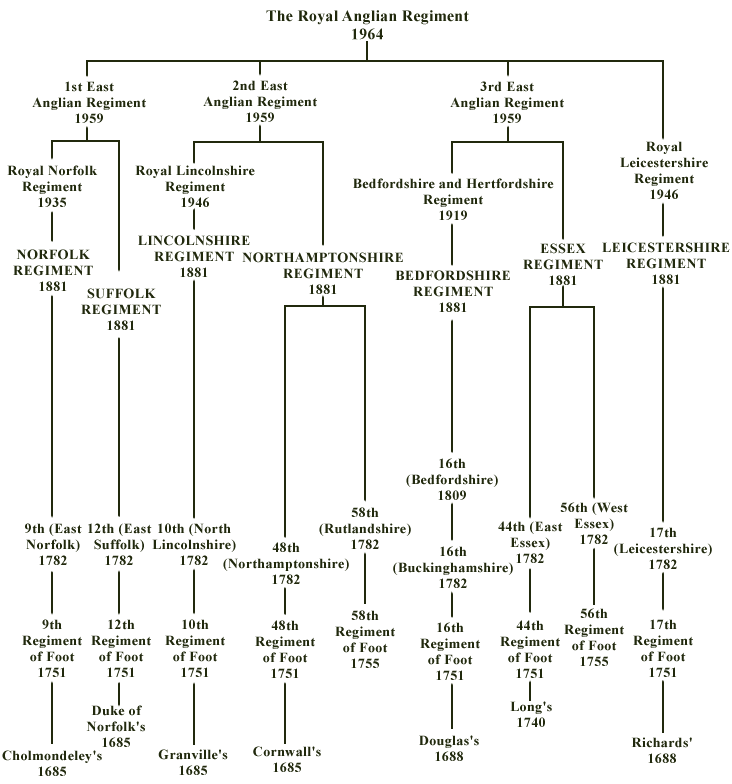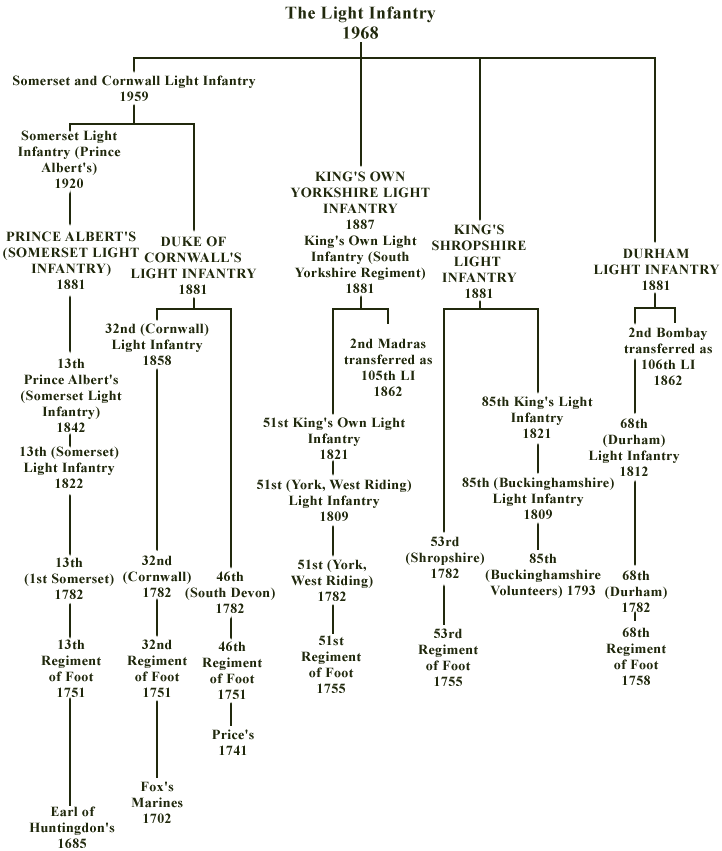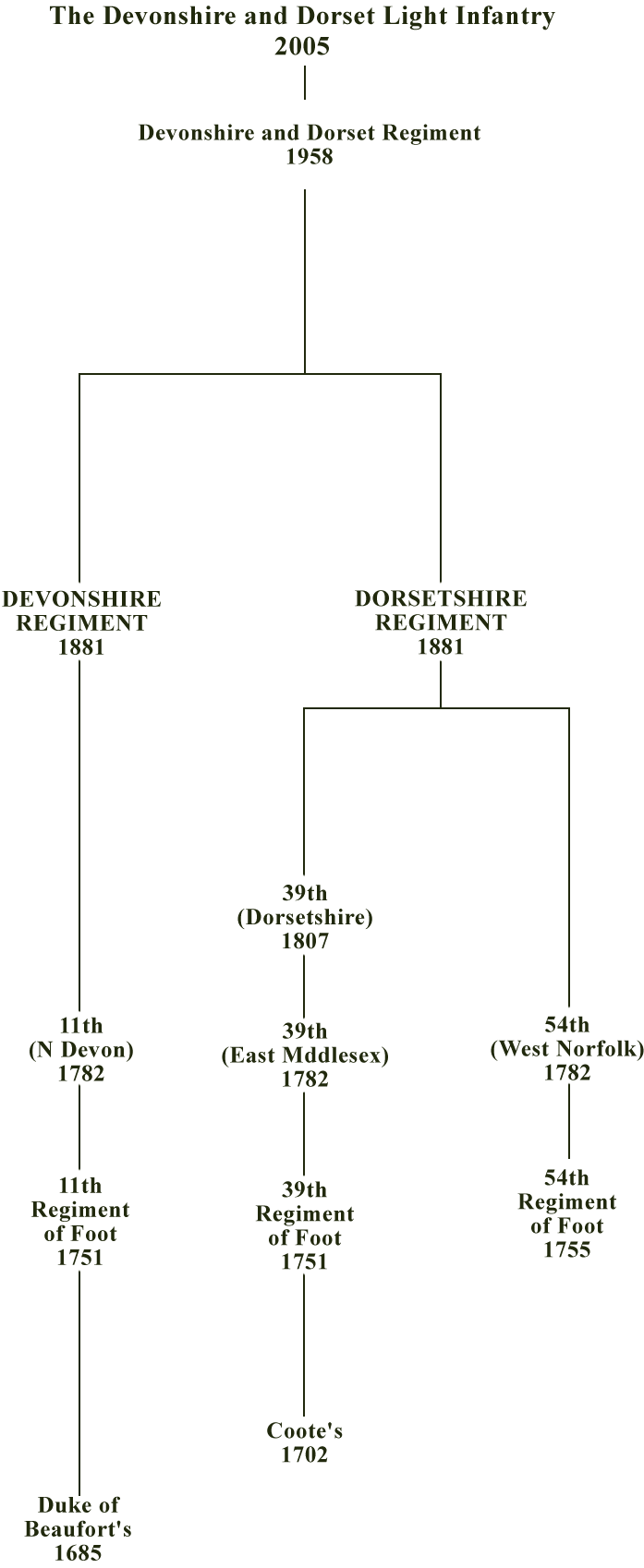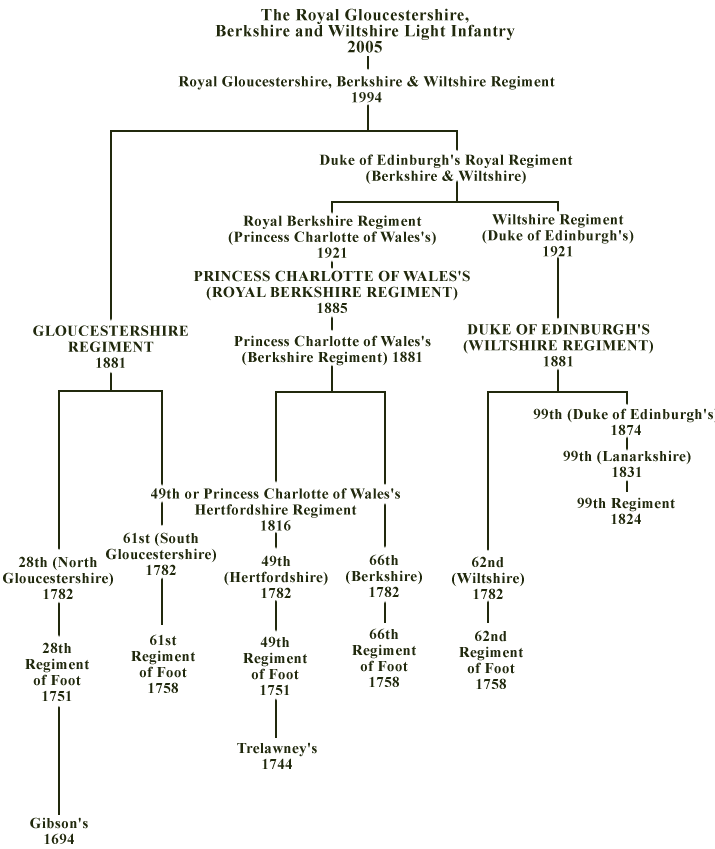
P.D. GRIFFIN
ENCYCLOPEDIA OF MODERN BRITISH ARMY REGIMENTS
The Colonel-in-Chief of the regiment, the Duke of Kent, upholds a tradition going back to 1789, when Prince Edward, later Duke of Kent, was appointed colonel of the 7th Royal Fusiliers. The regiment's privileged connections with the royal family were established by William IV, who sometimes dined with the 7th and bade its officers to dispense with the usual protocol that surrounds the drinking of the loyal toast.
The regimental mascot, an Indian blackbuck antelope, is kept in the care of two handlers and paraded at the head of the regiment. Wild antelopes of this variety were kept by the Royal Warwickshires from 1871, when the regiment first adopted one in India to complement its antelope badge.
St George's Day (23 April) is celebrated true to the ritual previously associated with the Royal Northumberland Fusiliers, with red and white roses fitted to badges, drums and colours. Roses were emblazoned on the colours of all the antecedent regiments in one guise or another. The RNF and RWF displayed a united red and white rose 'slipped', that is, with stalk attached as if torn from the main stock, a symbol used by the old regiments in Dutch service to show loyalty to Mother England across the sea. The Tudor rose on the RF badge was taken from the emblem stamped into the guns they used to guard in the seventeenth century. The Red Rose of Lancaster came from the Royal Lancashire Militia via the colours of the Lancashire Fusiliers to the regimental colour today. A drummer's colour of gosling green silk is allowed to be paraded on St George's Day, a privilege given to the 5th (Northumberland) Regiment in 1836 with its unique battle honour 'Wilhelmstahl'. This resolved the regiment's transgression in carrying French standards captured at Wilhelmstahl in 1762 against regulations. Bearskins issued with the regiment's fusilier achievement similarly satisfied its self-imposed right to grenadier caps brought from the battlefield and worn by the 5th to publicise its capture of the Grenadiers de France.

The antelope mascot between kneeling handlers in RRF full dress. (MoD)
Albuhera Day (16 May) honours the two battalions of the 7th Fusiliers which withstood shot and shell in the 1811 battle before delivering a resounding charge on their tormentors. The French infantry crumbled before the fusiliers' spirited charge and panic spread along its flanks to save the day for the British line, but at a cost: the 2nd Battalion had been destroyed and its cadre was returned home to recruit back to strength.
Minden Day (1 August) remembers the 20th Foot in Germany in 1759. Their motto Omnia audax (Daring everything) was never more true than at the Battle of Minden, when they were known as 'Kingsley's Stand' after refusing to retire from the firing line when ordered to, in view of their heavy casualties. A laurel wreath awarded to the regiment after the battle in respect of its courage is the origin of the wreath on the RRF badge today. The Lancashire Fusiliers observed Minden Day by wearing red and yellow roses in the tradition of most 'Minden' regiments. LF custom demands that officers new to the mess eat a rose from a silver bowl of champagne.
Gallipoli Day (25 April) commemorates the beach landings on the Dardenelles in 1915, where the Lancashire Fusiliers won 'six VCs before breakfast'. The ship's bell from HMS Euryalus, which delivered the Lancashire battalions to the beaches, was used to sound time in barracks. Gallipoli Day in Bury now remembers all Lancashire Fusiliers who gave their lives in the service of their country.
Normandy Day (6 June) marks the part played by the Royal Warwickshire Regiment in the massive operation of 1944, and the losses sustained in the assault on the German stronghold at Lebissey.
The regiment's foothold in the Wolfe Society comes via the LF. James Wolfe assumed command of the 20th Regiment in 1750 and staved with it until 1756, when the outbreak of war moved him on to higher command.

The first of the Army Council's Marge regiments' was created in 1964 by bringing together old county regiments of East Anglia and the east
Midlands, most of which had a history dating back to the seventeenth century and the reign of James II.

Royal Anglians band and drums, c. 1990. Note the eccentric brass edging on the helmets of the bandsmen behind the drummers
By 1970 battalion titles were giving way to battalion nicknames. The 2nd became known as 'The Poachers' because of its Lincolnshire content and its march of the same name, and the 3rd as 'The Pompadours', an old name of the Essex inherited from the 56th Foot, whose rose purple facings happened to be the favourite colour of Madame de Pompadour. The 1st Battalion, lacking a suitable nickname, chose to be 'The Vikings', a convenient warrior appellation drawn from east coast history.

Regimental headquarters are at Gibraltar Barracks in Bury St Edmunds, the former depot of the Suffolk Regiment.

Minden roses fixed to the beret on 1 August. The black patch behind the badge is said to commemorate the death of Sir John Moore at Corunna in 1809. He was buried by men of the 9th (East Norfolk) Regiment 'darkly and at dead of night'. (Grenadier Publishing)
The blue peaked cap with scarlet band bears the regimental badge, the castle and key of Gibraltar on an eight-pointed star, basically the badge of the East Anglian Brigade prior to 1964 in the smaller form favoured by the officers. The castle and key emblem was worn as a battle honour by four regiments of the British Army, three of which were destined for the Anglians: the Suffolk, Essex and Northamptons. The castle's accompanying motto, Montis insignia Calpe (By the sign of the Rock), was also included in the badge of the Suffolk Regiment. The castle and its motto were originally allowed to be borne by the 12th (Suffolk), 56th (West Essex) and the 58th (Rutlandshire) Regiments in 1836 to affirm their battle honour 'Gibraltar 1779-83', awarded just after the great siege in which a handful of British regiments held out against the combined French and Spanish armies and navies for four years. The star part of the badge, minus a cross and hart, was taken from the Beds and Herts' badge and resembles the Star of the Order of the Bath which appeared (with laurel wreath) on officers' belt plates of the 16th (Bedfordshire) Regiment from 1830.
Collar badges are worn to battalion pattern in this regiment. Members of the 1st Battalion wear the Suffolks' castle badge with the Norfolks' figure of Britannia superimposed, whereas soldiers of the 2nd sport the Lincolns' sphinx with the Northamptons' 'Talavera' scroll.
Royal Anglian Regiment (RAR) buttons were impressed with the regimental castle and star until the demise of the 4th (Leicestershire) Battalion in 1970, when it was decided to perpetuate the memory of the Leicestershire Regiment by showing its tiger and wreath badge on the buttons. The complete laurel wreath dates back to 1777 and represents the encirclement of the 17th Foot by Washington's army at Princeton, and Lt-Col Mawhood's reckless charge to break out of the Americans' cordon.
With the passing of the 3rd Battalion in 1992 its eagle badge, inherited from the Essex Regiment, was transferred to the remaining battalions in the form of a sleeve badge, worn near the left shoulder in the style of that of the Blues and Royals'. The Imperial Eagle, displayed on buttons of the Essex Regiment from 1902 and as a collar badge from 1954, is symbolic of the regimental eagle of the French 62nd Regiment captured by the 44th (East Essex) at the Battle of Salamanca in 1812.
1st Battalion uniforms are identifiable by a red and yellow Minden flash on the right sleeve, worn to honour the memory of the 12th Regiment at the Battle of Minden in 1759. Lanyards are worn in battalion colours: 1st Battalion wear a yellow lanyard to reflect the yellow facings of the 9th and 12th Regiments, a distinction restored to the Suffolks in 1899 and the Norfolks in 1905. The 2nd Battalion lanyards are black, the facing colour of the 58th from 1755 to 1881. Lanyards worn in the 3rd Battalion were rose purple, the facing colour of the 56th, returned to the Essex in 1936. TA battalions wear lanyards of two or three colours; companies based in Leicester wore the red/grey/black twist of the Royal Leicesters - grey for the old facings of the 17th Regiment, which were returned to the Leicesters in 1931, and black as a sign of mourning for the death of Gen Wolfe.

Colours of the 1st and 2nd Battalions at Duxford in 1995. (Grenadier Publishing)
The regimental quick march, Rule Britannia/Speed the Plough, from the Norfolks and Suffolks respectively, is sometimes played with The Lincolnshire Poacher. In this instance, Rule Britannia is not evidence of a link with the Royal Navy; it was chosen for the Norfolk Regiment to complement its Britannia badge. Speed the Plough, particularly apt for a regiment sometimes known as 'The Carrot Crunchers', is based on a seventeenth-century East Anglian folk tune.
The regimental slow march is that formerly played in the Northamptonshire Regiment, whose custom it was to play Rule Britannia and God Bless the Prince of Wales in the officers' mess.
The waltz, Destiny, was regarded with sacred respect in the Bedfordshire and Hertfordshire Regiment because it was a favourite of the 1st Battalion band just before the embarkation to France in 1914, where its destiny was to witness the destruction of the regiment at Mons, Le Cateau, the Marne, the Aisne and Ypres. The Pilgrim's Hymn was adopted in 1941 to commemorate Bedford's link with John Bunyan, author of A Pilgrim's Progress.
The quick march, A Hunting Call, which evoked the fox-hunting traditions of Leicestershire, was played in the county militia from 1860 and adopted as the regimental march of the Leicesters in 1933. Their slow march, General Monckton 1762, indicated the colonel of the 17th Foot and the date he composed the piece.

The 44th Regiment re-enactment group in 2005, displaying drills and tactics of the 2nd Battalion the 44th (East Essex) Regiment in the Peninsular War
Formation Day (1 September) celebrates the 1964 amalgamation, which brought the eastern county regiments together as Royal Anglian on parade grounds in England, Germany and Arabia.
The 1st Battalion anniversaries are headed by Minden Day (1 August), when roses are worn on headgear in the custom of the Suffolk Regiment, whose forebears stopped to pick roses for their hats en route to the battle line at Minden in 1759. A red and a yellow rose were worn in the Suffolk on Minden Day in remembrance of this and also on the sovereign's birthday, a tradition that began in an earlier battle on German soil. At Dettingen, Duroure's Regiment (the 12th) accompanied King George II on the field and chose to remember the honour by wearing fern leaves on his birthday. Dettingen Day (27 June) is also celebrated in 1st Royal Anglian.
St Patrick's Day (17 March) and Salamanca Day (22 July) are observed in memory of the capture of a French eagle standard by the 2nd Battalion of the 44th (East Essex) Regiment at the Battle of Salamanca in 1812. It was customary for the Essex Regiment's Corps of Drums to play Irish airs at reveille in honour of this Irish battalion, raised for war in 1804 and disbanded at its end, in 1816. The eagle trophy was consigned to the Royal Hospital at Chelsea and entrusted to the regiment in the twentieth century.
Almanza Day (25 April) was kept by the Norfolk Regiment in memory of the 324 men of the 9th Foot who were killed or wounded out of a field strength of 467 at the 1707 battle in Spain. It is popularly believed that the figure of Britannia was conferred on the regiment by Queen Anne for the courage displayed by the regiment in the battle. A century later the 9th were in Spain again, their belt plates shining with Britannia.

Royal Leicestershire Regiment drummers, c. 1963. Full-length tigerskin aprons were adopted for all drummers of the regiment in India during the 1920s to promote the regimental badge and nickname. (Leicester Mercury)
Locals mistook her for the Virgin Mary and other regiments took the opportunity to mock the 9th as 'The Holy Boys'.
Sobraon Day (10 February), from the Lincolns, celebrates the remarkable advance of the 10th Regiment on the Sikh artillery at Sobraon in 1846. It is said the battalion marched through a hail of shot and shell in perfect order and with a silent progress that chilled the enemy.
Hindoostan Day (25 June) is what the Leicesters knew as Royal Tigers Day. It celebrates the time in 1825 when King George IV approved a tiger emblem for the 17th (Leicestershire) Regiment to mark its nineteen years of active service in India between 1804 and 1823. The tiger, superscribed HINDOOSTAN, became the cap badge of the Leicestershire Regiment, whose members revelled under the collective nickname of 'Tigers' as a result.
Talavera Day (27 July) honours the 48th (Northamptonshire) Regiment at the Battle of Talavera in 1809. In the heat of the battle the 1st Battalion was rushed forward to strengthen a weak point in the line and the Duke of Wellington afterwards wrote of how 'the battle was certainly saved by the advance, position and steady conduct of the 48th'. The Northamptonshire Regiment displayed the battle honour 'Talavera' on its cap badge, and on its collar badge in the form of a wreath around its Militia shield, which displayed the Rutland horseshoe. On Talavera Day in the officers' mess a silver cup, purchased in 1877, would be charged with champagne at dinner and passed round in a solemn toast to Col Donellan and his men who fell on that day.
Blenheim Day (13 August) remembers the 16th Regiment of Foot at the Battle of Blenheim in 1704, when it was registered among those sustaining the highest casualties. Blenheim was the regimental day of the Bedfordshire Regiment.
The Royal Anglians' membership of the Wolfe Society came through the Suffolks, Leicesters and Northamptons. James Wolfe and his brother Edward served as ensigns in the 12th of Foot, and carried Col Duroure's colour at Dettingen. His motto Stabilis (Steady) was adopted unofficially by the Suffolk Regiment. The 17th Foot fought under Wolfe at Louisburg in 1758 and the Leicestershire Regiment honoured his memory in several ways; the band played Wolfe's Lament on 1st Battalion church parade, the officers' grey mess waistcoat was heavily braided in black and the mess silver was encompassed by black crepe on guest nights. The Northamptons' connection lay with their 48th and 58th Regiments, both of which fought under Wolfe in his Canadian campaigns of 1758/9. When he fell mortally wounded at Quebec it was the surgeon of the 48th who attended him.
A regiment's drums are respected for the honours emblazoned on them, and consequently protected when danger threatens. The Bedfords' Mons drum was the sole survivor of a set that was urgently thrust into the care of French villagers during the Mons offensive of 1914. It was eventually traced and returned to a place of honour in the regiment where it was paraded on special occasions. The Cambridgeshire Regiment TA, which was seconded to the Suffolks in 1961, buried its drums in the jungle at the time of the fall of Singapore in 1941. They were recovered in 1945, but only paraded in silence thereafter as a solemn mark of respect for the 784 Cambridge lads who never returned from Malaya.

In 1968 the four regiments grouped together as the Light Infantry Brigade were amalgamated into one large regiment. The term 'light infantry' was first used in the eighteenth century for companies selected to operate in the rough country of North America like the natives, unfettered by parade ground uniforms and rigid martial doctrines. In 1802 Sir John Moore opened a training school at Shorncliffe, where he gave birth to the Light Division, a term still used today to embrace the Royal Green Jackets (RGJ) - as Moore's infantry became - and the Light Infantry (LI), which represents the English county regiments that were converted to the light role after 1808.

Light Infantry colour serjeant in the regiment's green No. 1 dress, with the 'wrong way round' sash and Inkerman chain. The use of the beret with ceremonial attire is a rare sight among infantry regiments without hackles. (Grenadier Publishing)
Regimental headquarters LI, first established at the KSLI barracks in Shrewsbury, were later moved to Winchester, the training base of the Light Division and traditional home of the 'Greenjackets'.

Drummers of the Devonshire and Dorset Regiment in full dress with the green pagri adopted to distinguish their helmets from those of the Royal Marines

The back badge on the cap and cross-belt of Drum Maj Scaife (2nd Gloucesters), 1935. (Gloucester Regiment Museum)
As a result of army restructuring announced in 2004, two infantry regiments from the Wessex region were converted into the Light Division - the Devonshire and Dorset (D&D) and the Royal Gloucestershire, Berkshire and Wiltshire (RGBW). In 2007 all battalions of the Light Division - Light Infantry, Green Jackets and Rifle Volunteers (TA) - will unite as one regiment under a title resurrected from Green Jackets' history: The Rifles.


Prince Alfred of Edinburgh in a rifles officer uniform of the 2nd Volunteer Battalion the Devonshire Regiment in 1895
The Rifles' green peaked caps (officers) and berets (other ranks) follow a light infantry tradition that began in the years of the shako (1800-78), when light companies were distinguished by plumes or pom-poms of green.

The Victorian universal helmet, normally covered in blue cloth, was covered in dark green for regiments of light infantry.

The silver-strung bugle horn, which is worn on cap, beret, collar and buttons, is the same as that adopted by the light companies in the 1780s and maintained by the 'Light Bobs' ever since, in one form or another, with regimental embellishment. It emulates the old bugle horn used by hunters in the chase and by light infantry to sound communications in barracks, on the march and in the field. Known as 'half a cap badge' because of its semicircular form, the bugle is worn with a red ground between the horn and its strings, a distinction borrowed from the badge of the Duke of Cornwall's Light Infantry, who used it to symbolise a privilege of its 2nd Battalion, the old 46th Regiment. Drummers and light company men of the 46th were permitted a red pom-pom on their shakos to celebrate an audacious night attack by the light company of the 46th Regiment on an American camp by the Brandywine river during the American War of Independence. The victims swore vengeance on their 'surprisers' and the cocky lads who went to make up the light companies of the 46th and 49th Regiments duly obliged by wearing conspicuous red feathers in their caps to attract any unfinished business.
The RGBW badge, which is basically the Wiltshires' cross mounted with the Gloucesters' sphinx, is also worn on a red backing to echo the red feathers sported in North America, in this instance by the light company of the 49th. On the beret this takes the form of a long red triangle - the Duke of Edinburgh's Royal Regiment's (DERR) Brandywine flash.
A small sphinx badge, uniquely worn (within a laurel wreath) at the back of cap and beret, originated with the 28th (North Gloucestershire) Regiment, whose soldiers fitted a plate pressed with the sphinx on the back of their shakos to commemorate their back-to-back stand against a two-pronged attack in the Batde of Alexandria in 1801. The larger version of the back badge, struck during the First World War to mark a similar manoeuvre at Festubert, proved unpopular and a reversion to the small badge was made in 1935.
The D&rD badge is made up of the Devons' Exeter castle and motto superimposed with the Dorsets' sphinx and motto. The sphinx, on a tablet marked EGYPT, was awarded to all the regiments involved in the 1801 campaign to rid Egypt of Napoleon. The sphinx displayed by the Dorset Regiment was different in that its tablet inscription was altered in 1841 to MARABOUT, a battle honour given to the 54th Regiment when its prized trophy, a gun taken at Fort Marabout (near Alexandria), was finally handed in, forty years after the battle. The Marabout Gun now resides in the Dorset Military Museum in Dorchester.
Warrant officers and serjeants of the LI are authorised by custom to two items of dress that commemorate battles in which sergeants had to take on the responsibilities of their officers. The red sash of rank is worn over the left shoulder, which is opposite to the regulation side for sergeants and warrant officers of the British Army. This distinction of the Somerset Light Infantry was adopted by sergeants of the 13th Regiment who had stood in for officers felled in battle and who wore their sashes like officers at that time, from the left shoulder with the knot on the right hip. The Inkerman chain, which is worn suspended from the sash, was inherited from the Durham Light Infantry. It attaches to a whistle used by light infantry officers and sergeants in the nineteenth century to marshal their companies about the battlefield. At the Battle of Inkerman in 1854 officers and sergeants of the 68th manoeuvred their men out of danger of a strong Russian flanking movement. Inkerman Day (5 November) was observed in the regiment up to the 1968 amalgamation.

The hand of the Light Infantry, 1989
Officers wear the whistle chain from a black leather cross-belt today, while other ranks wear a black leather waist belt, both accessories of rifle regiments now used throughout the Light Division.
Buglers are issued with light infantry No. 1 dress (green tunic with bright buttons and blue trousers with a green stripe) and a rifles busby that conforms to the type worn in the Royal Green Jackets, another concession to uniformity in the Light Division. Drummers of the Devon and Dorset Regiment wear traditional infantry scarlet but with white marine helmets to mark the regiment's close links to the sea and its history of marine duty: the 39th at Cape Passaro in 1718, the 54th at Gibraltar in 1756-65 and the 11th at Cape St Vincent in 1797.
The Shropshire and Herefordshire Battalion (TA) wear a Croix de Guerre cockade in No. 1 dress to honour the ribbon awarded to the 4th Battalion KSLI in recognition of their gallantry at La Montague de Bligny on 6 June 1918. A Croix de Guerre ribbon granted to the Devonshire Regiment by the French government for bravery in battle at Bois des Buttes in 1918 is worn as a sleeve badge in the D&D, a custom begun in 1939. The blue rectangle worn by Gloucesters at the top of the sleeve represents a US Presidential Citation made to the regiment for its outstanding courage at the Battle of Imjin River in 1951.
LI officers and seijeants wear a lanyard of rifle green in barrack and service dress. Grass- green lanyards of the D&D reflect the facing colour of the regiment reauthorised to the Dorsets in 1904 and to the Devons in the following year. The colour had inspired nicknames like 'The Green Linnets' for the 39th and Popinjays' for the 54th in the eighteenth century. Stable belts are of corresponding greens, those of the D&D enlivened with a central stripe of tawny orange.

Light Infantry at the double with rifles at the trail, c. 1980
We have much more interesting information on this site.
Click MENU to check it out!
∎ cartalana.com© 2009-2025 ∎ mailto: cartalana@cartalana.com